It’s been a couple of years since we went down there, since the thimble-brained yahoos staged their occupation. Our friend Brandon wanted to get a “we survived the occupation” shirt or cup at headquarters, but they didn’t have one. Probably too soon to see the humor in that utterly moronic event.
Malheur is our favorite birding place. It takes us eleven and a half hours to get to Frenchglen from home, which is a bit much on one day. Definitely, we’re going to have to split that up into shorter driving times from now on, and take more days to get to and fro. We’re toast today and we came home a day early because the idea of that many hours of driving was weighing heavily on our minds.
Friday was the day we left, and the weather gods decreed we were going to get up earlier than we’d planned, courtesy of a rock and roll thunderstorm on top of our house, that started at 4:03 AM. We got off to a very early start, and it’s a good thing because it actually took longer to get there than we remembered. And it thunder stormed on top of us pretty much the entire drive down. Saturday, as predicted, the weather was rainy off and on, totally cloudy and extremely windy and it was 46F for the high, so it was cold all day. Amazing how the birds don’t seem to mind that sort of weather, other than they stayed down, and we didn’t hear Cranes calling from where we stayed.
Overall it’s very hard to take bird pictures, so I didn’t end up with very many, all things considered. First the light has to be right; second they have to sit still; and third, they can’t be so far away you wish you’d brought along a spotting scope. Really do need to remember to pack that in the car. It’s hard to bore people with bird pictures unless you HAVE some.
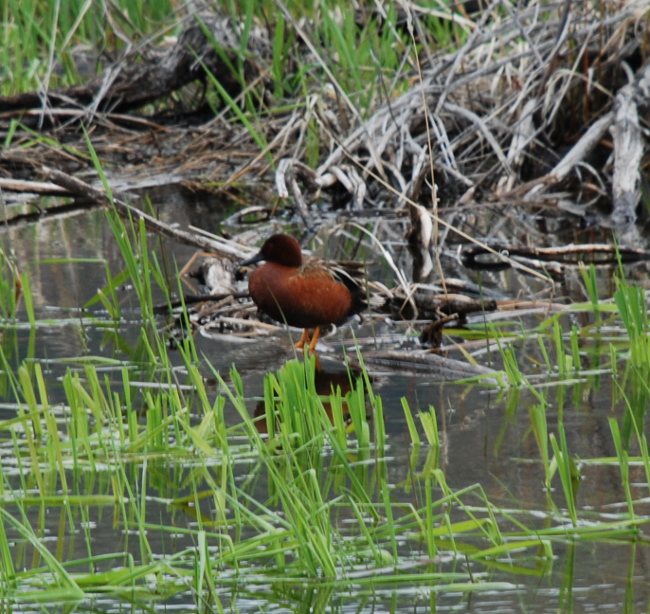
Cinnamon Teal are just beautiful little ducks, and it seems like they are in every puddle. The grass is just starting to come up; when it gets taller, these little birds will disappear.
Cinnamon Teal are the most common of all the teal on the refuge. We also saw Blue-winged Teal, but just briefly as they came in for a fast landing to a pond, behind heavy dead marsh grass.
I didn’t take any pictures of Mallards, or Coots. But I did get some other duck pictures.
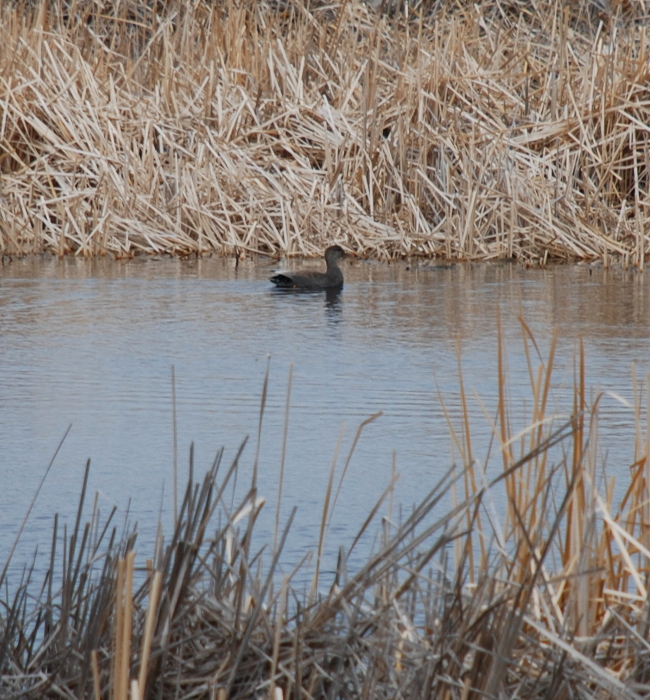
I’ve always thought Gadwall are kind of nondescript. I’m sure they aren’t very impressed by the way humans look either.
Shoveler’s are pretty amazing looking. Look at the beaks on those guys and you can see why they have that name!
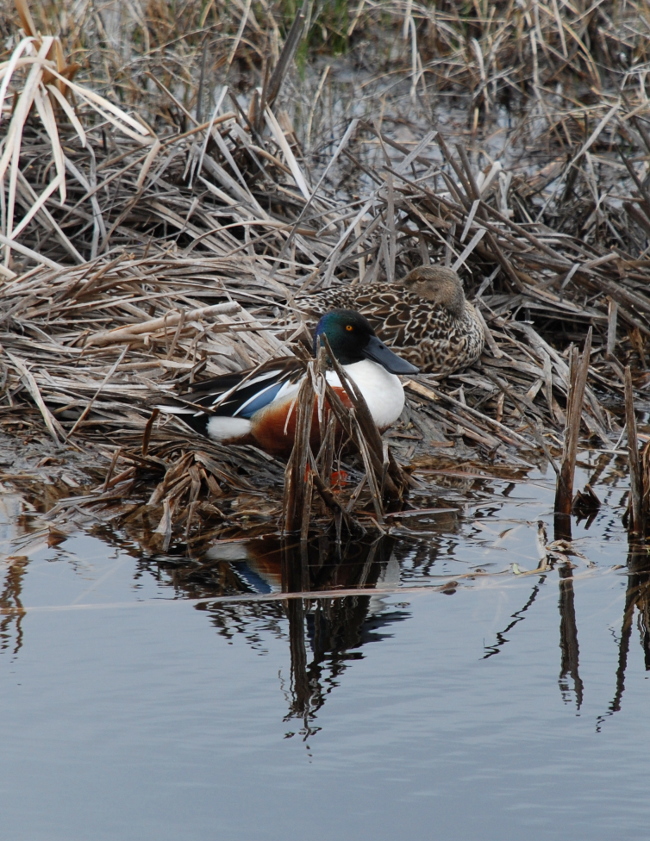
You can just barely see the hen sitting behind her boyfriend. She totally blends into the background.
Northern Pintails are a duck I remember very clearly from Alaska. It was always such a treat to see them come back in the early summer.
Sandhill Cranes are one of the highlights to see at the refuge and we saw a pair with babies that just hatched. They could barely clamber over the tall grass. It was disappointing not to hear them calling. It’s a very prehistoric sound that gives me goosebumps, in a good way.
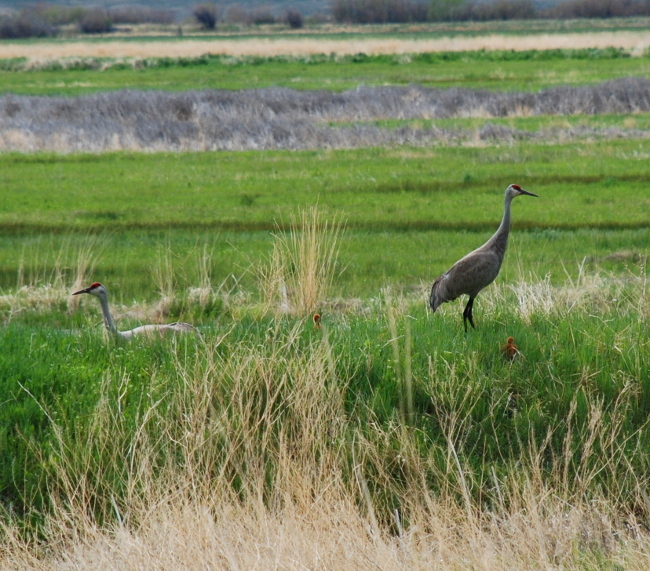
A pair of cranes with their just newly hatched babies. One is near the feet of adult on the right and another is peeping up in the grass in the middle.
The baby on the right was sort of climbing up the bank of an irrigation ditch. A very scary place to be, though I bet he or she actually would float if they fell in. Still, yikes, climbing back out again might prove fatally difficult!
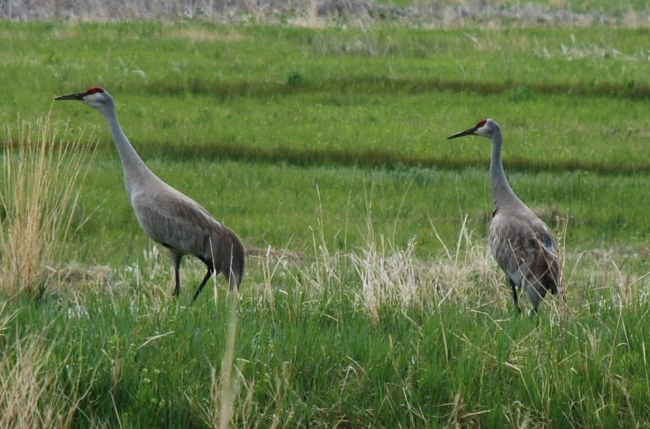
And then poof, the babies completely disappear in the grass. It’s hard to believe they will be the same height as the adults, and flying around the refuge, within a few months.
At the Headquarters we saw a Say’s Phoebe that was being cooperative in allowing a picture to be taken.
Yellow-headed Blackbirds were taking advantage of the feeders.
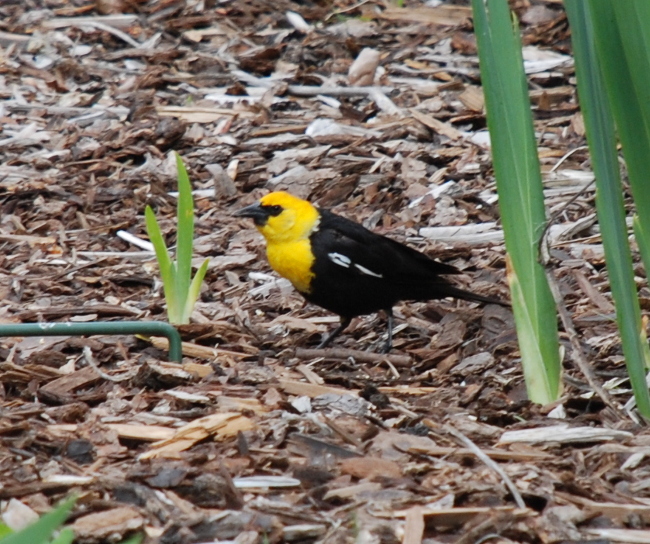
The first time I saw these was at Malheur, in the fall. We drove past a field of corn which had been harvested, and hundreds of these birds all rose into the air at the same time. It was spectacular. Well either it had been harvested or they had just decimated some farmer’s crop 🙂
A lone American White Pelican was occupying the pond next to the main offices, and all the rest of his cohorts were no doubt out on the large lake.
The highlight of the trip was a family of Great-horned Owls nesting in one of the volcanic craters at Diamond Craters. It was spooky walking up to the rim of the crater but we knew they were in there thanks to our friends Casey and Carmen who had been there the weekend before and told us precisely where to look. You can see the upright pale gray cone standing up on a rock? And then if you look closer, the parent is glaring at us from under a rocky outcrop.
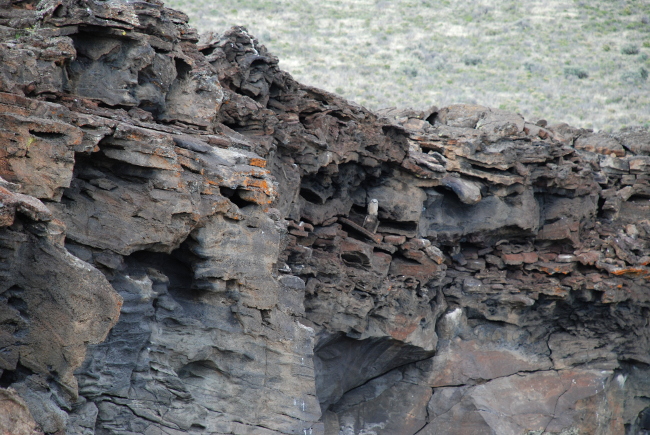
This crater is a good 40 to 50 feet deep. If you don’t like heights, standing next to the edge is really frightening. See the little pale bird perched on a rock on the end of the cliff? He looks like an upright cone.
We never would have seen these birds, had it not been for Casey and Carmen. Thanks guys!!!. Until we we got around to see this particular wall of the volcanic crater, they were completely hidden from view but then viola! Surprise!
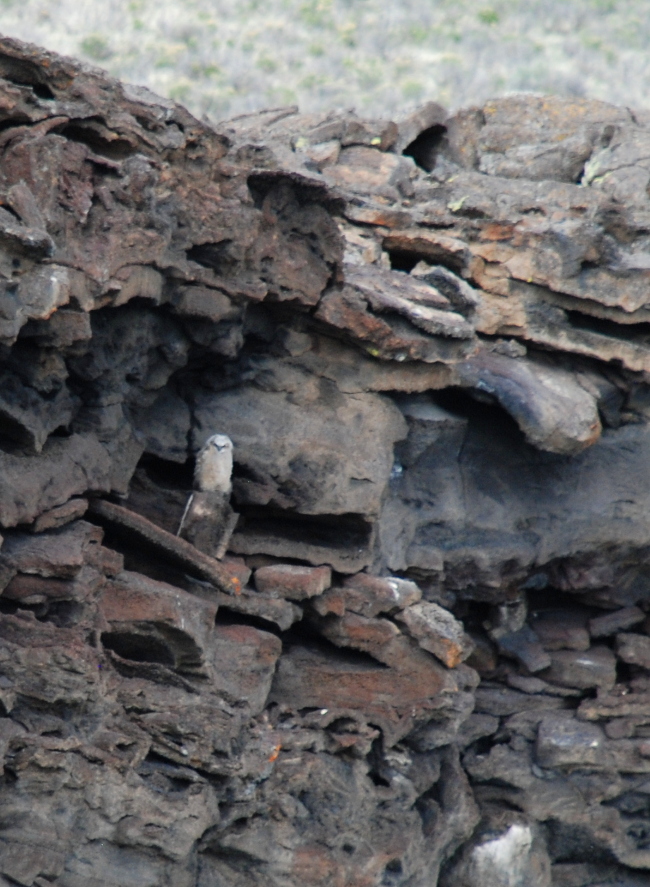
Still all downy, no adult feathers showing, this owlet was studying us as we were studying him. Look down and to the right, and you’ll see a parent, glaring up at us.
A bit farther along we saw a Raven sitting on a nest in a similar volcanic rock cliff. And in the middle of the Round Barn is another Raven nest. We saw a Raven on that same nest the last time we were in Malheur two years ago, and it wouldn’t be the least bit surprising if it wasn’t the same pair. The Round Barn was also completely full of Cliff Swallows.
Here’s a complete list of the species we saw, in the order in which we saw them.
Redhead
Sandhill Crane
White-faced Ibis
Franklin’s Gull
Long-billed Curlew
Yellow-headed Blackbird
Willet
Kildeer
Red-winged Blackbird
Brewer’s Blackbird
Cliff Swallow
Great Blue Heron
Great Egret
Snipe
Swainson’s Hawk
Common Tern
Western Kingbird
Yellow Warbler
Blue-winged Teal
American Magpie
Gadwall
Cinnamon Teal
Northern Harrier
Red-tail Hawk
Turkey Vulture
Common Yellowthroat
Common Crow
Brown-headed Cowbird
Western Meadowlark
American Coot
American White Pelican
Ring-necked Pheasant
Say’s Phoebe
Yellow-rumped Warbler – migrating through Headquarters, the trees were full of these guys.
Tree Swallow
Mourning Dove
Western Tanager
Ruddy Duck
White-crowned Sparrow
Barn Swallow
Pied-billed Grebe
Canvasback
Northern Pintail
Marsh Wren
Song Sparrow
Osprey
Cedar Waxwing
Northern Flicker
Loggerhead Shrike
Great-horned Owls – cool!!!!!
Rock Wren
Prairie Falcon – always a good trip when you can see a Prairie Falcon. This bird was on the telephone poles heading towards the Diamond Craters, and when we spooked it off it’s perch by stopping the car, it decided to take it out on a totally innocent Red-tailed Hawk who was sitting two poles farther down the road.
California Quail
American Widgeon
Lesser Scaup
Ring-necked Duck
Bufflehead
Sora
Empidonax Flycatcher. This could have been a Gray, Hammond, or Dusky.
Common Tern
Trumpeter Swan
Robin
Merlin – this bird was actively hunting singing sparrows up on the Steens Mountain road we walked up on Sunday morning.
Horned Lark
Lark Sparrow
Brewer’s Sparrow
Yellow-breasted Chat
Black-crowned Night Heron
Ring-billed Gull
Common Merganser
Black-legged Stilt
Reading over our trip list, it’s really shocking to see how many species are missing. Never know what you’re going to see, or not see, at Malheur. And no doubt I forgot to write some of them down, like Raven, for example.
Our cat and parrots were happy to see us (I’ve had a gray shadow all day), the seedlings on the table in the sun room are taller than they were when we left and there are more of them; and some other seeds have come up in the greenhouse. We need to get busy and do more planting.
And the river is flooding, almost as high as we’ve ever seen it. Another six inches higher and it will be the highest we’ve seen in the eleven years we’ve been here. The flooding started overnight. It was normal spring high water when we left on Friday morning; Saturday it wasn’t flooding, and Sunday it was – a lot. Could be interesting around here if we keep getting the rain they are predicting for this week, and it doesn’t freeze in the high country. There’s still a lot of snow in the mountains.
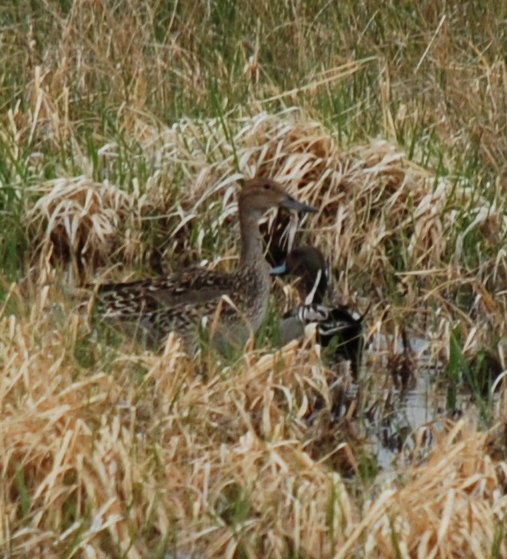
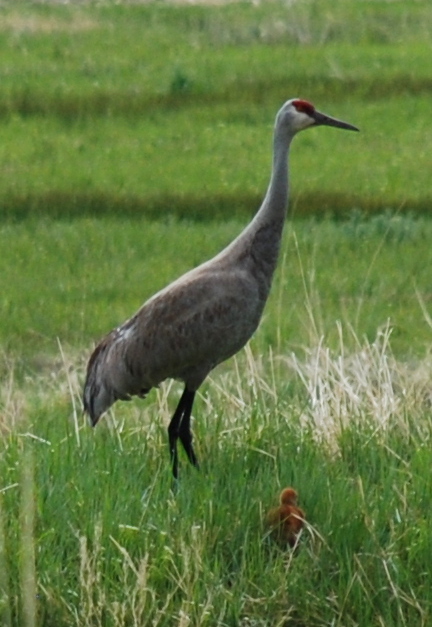
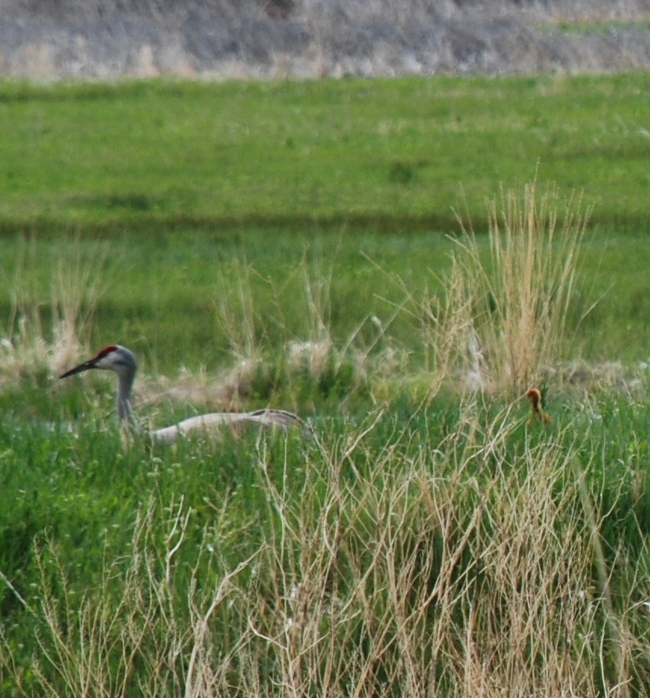
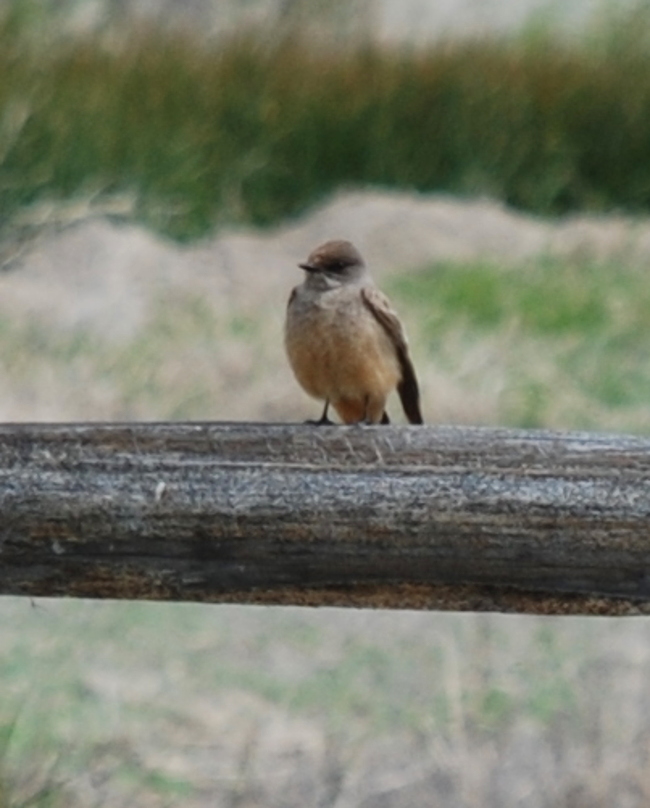
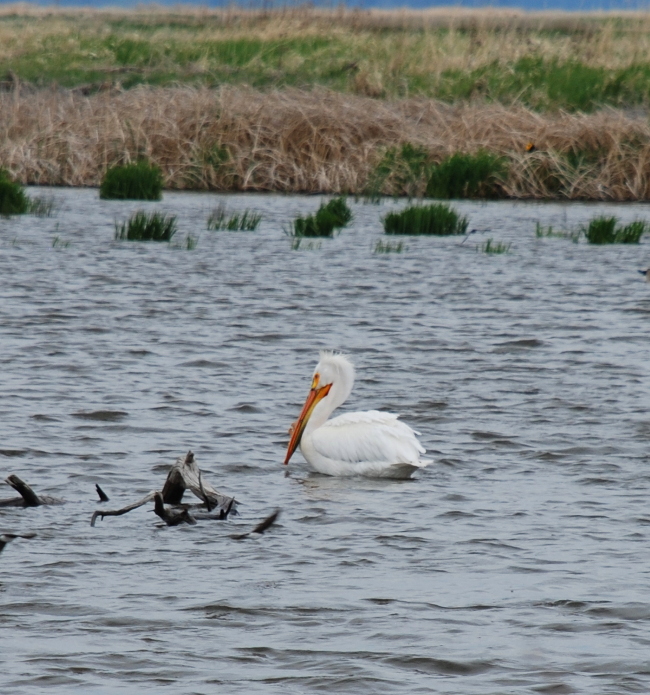
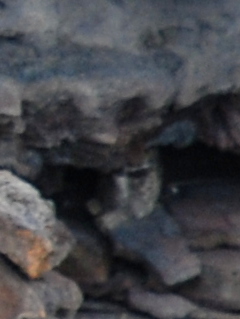
Lovely pictures, a wonderful description of your visit and a truly impressive knowledge of birdlife. It’s kind of sad that I, on the other side of the world, have heard of and remember the Malheur occupation, but have neither heard of nor could recognize the vast majority of the birds on your list.
Eleven years? My, how time flies. All the best wishes to you and the big man!